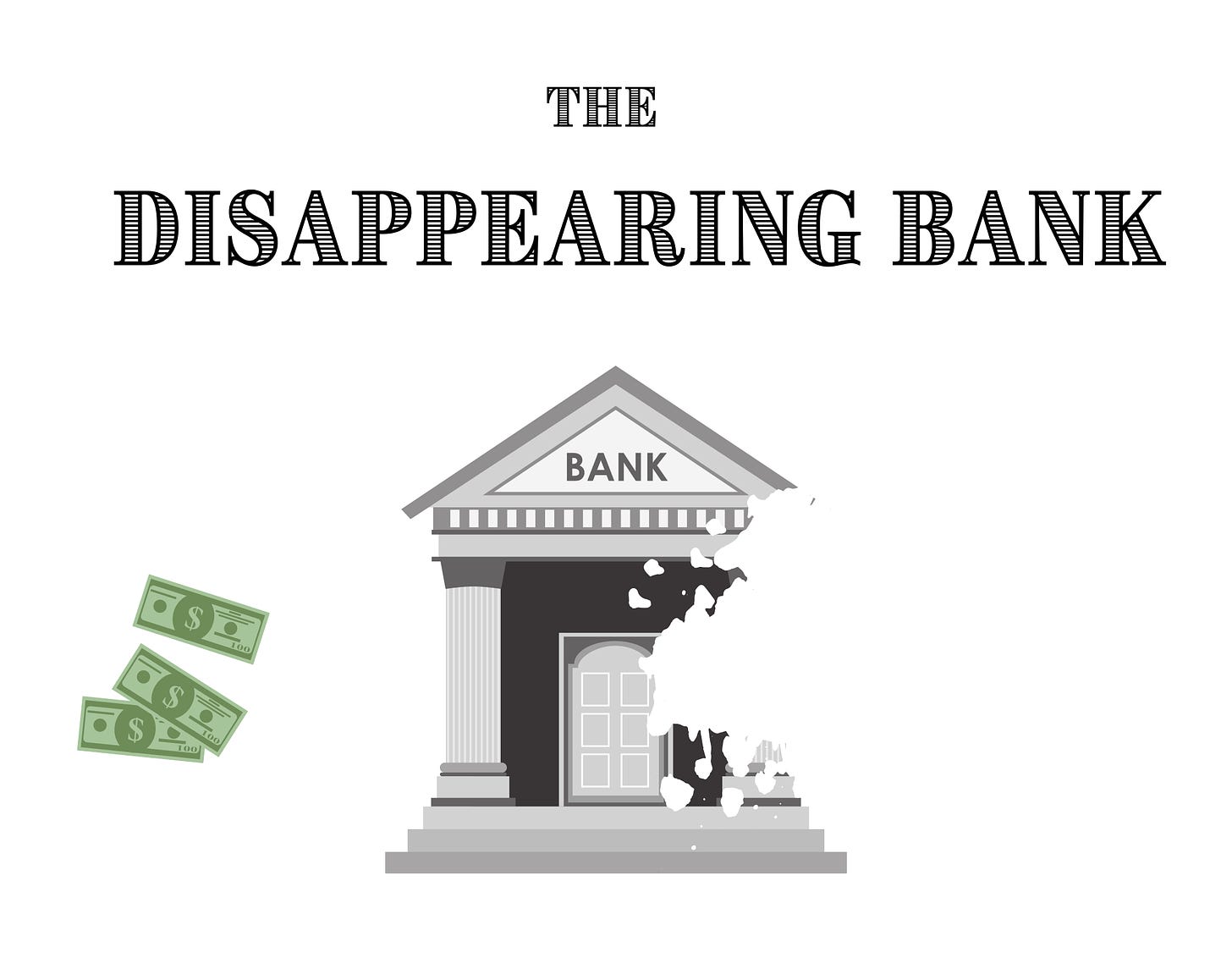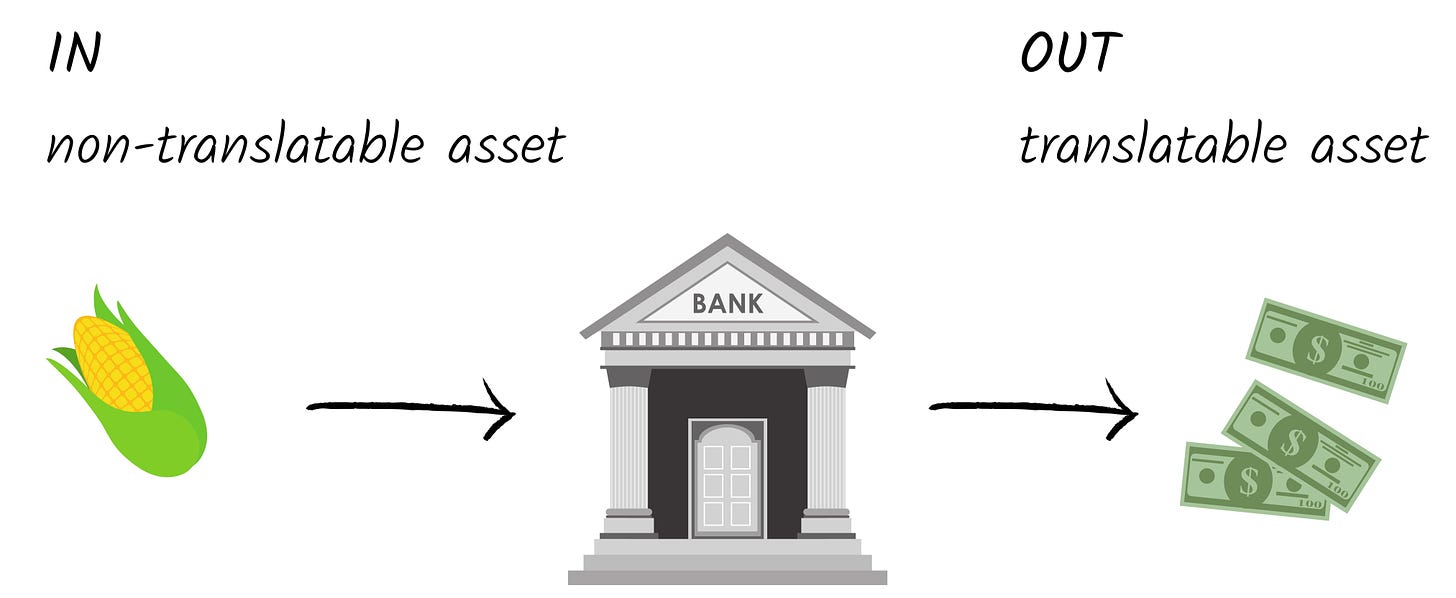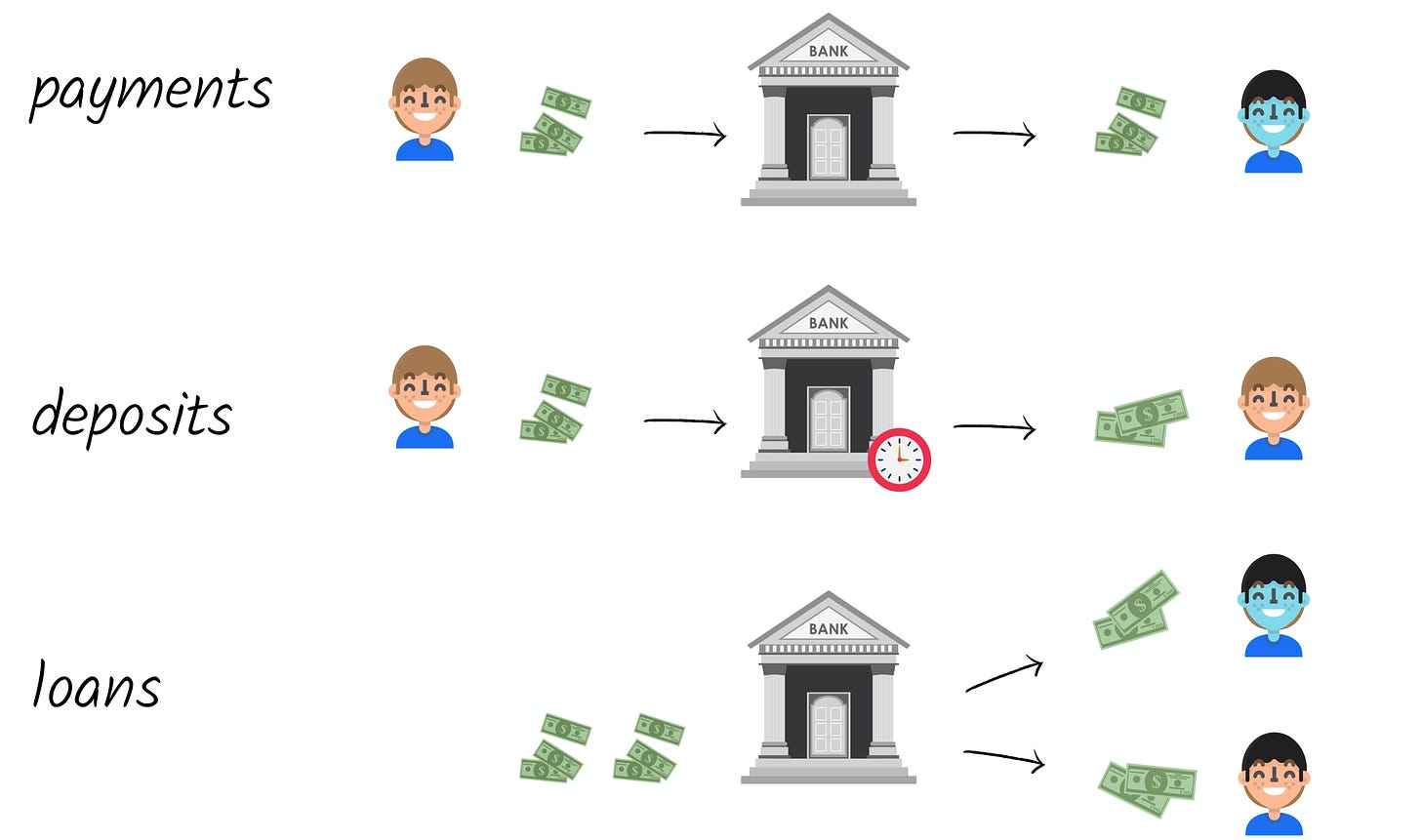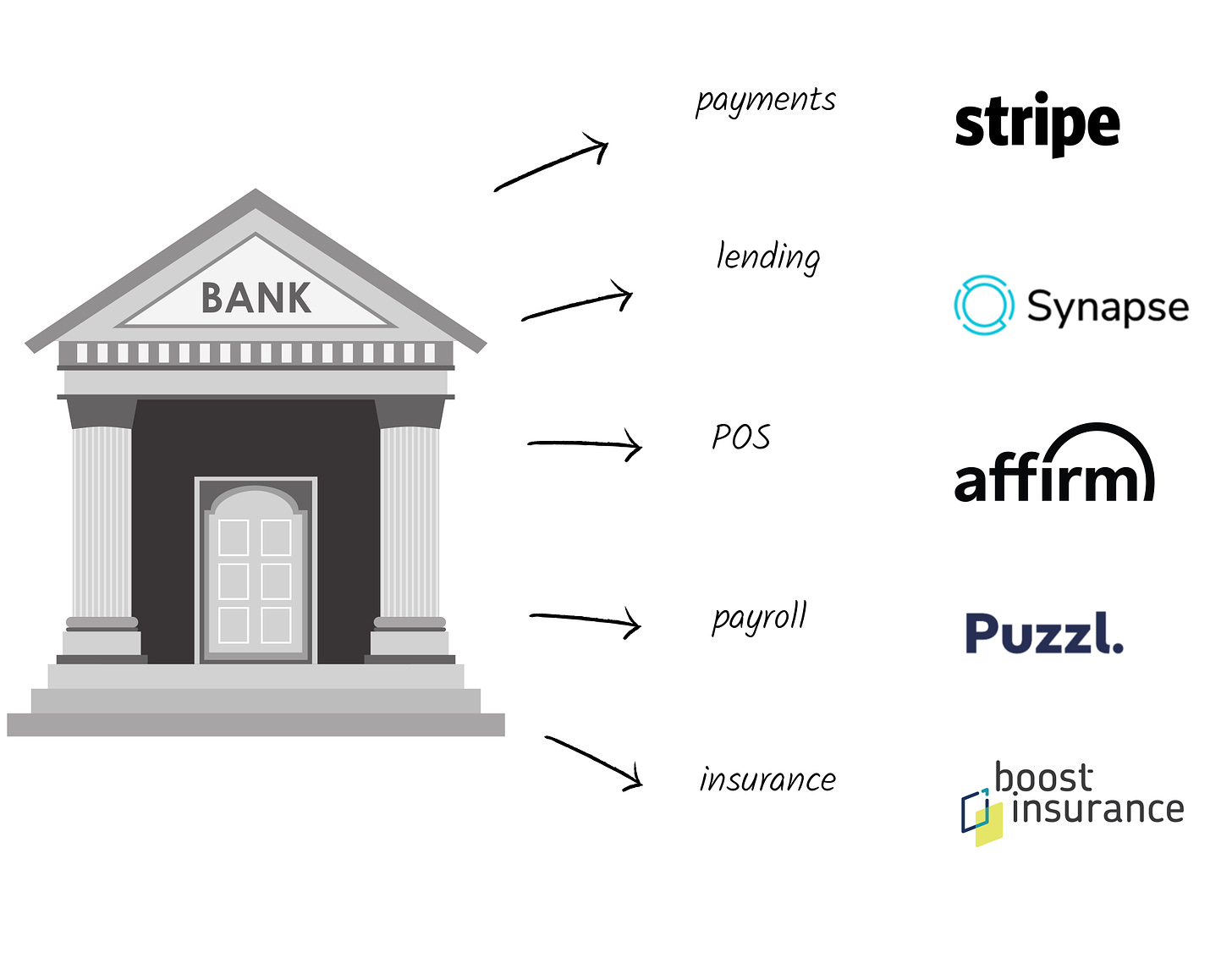The Disappearing Bank

Brief: Banks are increasingly replaceable. "Embedded finance" makes it easy to deliver financial services in context. Over time, that may result in money gravitating towards influencer-run financial institutions. This could have significant ramifications for how society manages its surplus.
In 2014, I tried to start a bank.
Perhaps if I tell you the other ideas I considered, you'll get a sense of how prepared I was for this effort.
A "fun" weather app. I was very light on the particulars of what would make it enjoyable.
A review site for bars called "BottlecApp." I am not sure which came first, the terrible pun or the terrible idea.
A video dating app. Instead of pictures, you could view short clips to get a sense for the person before committing to meeting. Not a dreadful idea but undercooked and underwhelming.
"Man is the only animal that blushes. Or needs to," Mark Twain said. In recounting this list, I felt a heat rise in my cheeks, a twinge of my embarrassment that lives six years later.
In the future, I may look back on myself now with similar chagrin, but something about that period, my early twenties, feels particularly cringeworthy. It was a time of great certainty and great unrest, impatience and aimlessness.
Beyond it being the best of a bad lot, I am unsure why I settled on banking. Partly, I think it has to do with the stories we tell ourselves, about ourselves. The various destinies we concoct, depending on the circumstances. As the son and grandson of bankers — the first who began his career in Italian-controlled Libya, the second in Chicago — there was a certain symmetry, of rightness, in trying to create a new, global financial institution.
I was not alone in this decision-making process, having joined forces with two of my best friends. Together, the three of us set out to build Willo.

A sad man hunched over his desk: the perfect imagery for a social app
At its core, Willo was a social financial app that allowed you to spin up "bank accounts" for differing needs, whether that was a group of roommates tracking rent, a club collecting dues, or a couple creating a lightweight joint account. You could collect money from different parties, set permissions on who could withdraw (and how much), and keep track of spending.
At the time, it was most similar to Tilt or Splitwise, but the point wasn't to raise money or divvy a bill; it was to create fully-functional group accounts as quickly as a group text. Today, Braid, a Charge portfolio company, brings that premise to life much more elegantly than I could have.
If there was any differentiated insight we had, it was this: a bank is not a thing, an entity, so much as a set of behaviors. Already, in our interactions with each other, we act as financial agents — paying one another, lending, saving together — what would it mean to provide tooling to enable that? To make a bank both pervasive and invisible?
An intriguing idea, perhaps, but that did not help us. Willo went nowhere. The fault was mine, mostly. In my role as "CEO," I had neither the experience nor skill to put us on the sort of hyper-learning trajectory needed for three startup ingenues. But there's another mitigation, convenient, yes, but still valid: we were too early.
This is the most self-congratulatory way to fail at the game of startups — to be so visionary, you have to wait for the world to catch up. But when I look at the state of fintech today, at the spread of embedded finance, the rise of the creator, I see a different landscape. One that might have been friendlier to Willo's ambitions. We are entering the era of the disappearing bank. It may fundamentally alter how society manages its surplus.
Banks and surplus
Beginning with grain loans in 2000 BC, banking transformed into the byzantine set of operations that define today's financial sector. Despite that steady convolution, there are a few consistent functions banks fulfill, across centuries.
Banks transform untranslatable assets into money, a translatable asset. Historically, that might have involved exchanging commodities for coins. More modern examples include asset-backed loans — a small business might receive money from a bank in exchange for the right to the company's machinery. While the mechanism is different, the end is the same: make value translatable "across space and time."

Once made translatable in the form of money, banks facilitate three fundamental activities: payment between parties, storage of funds for future use, and the dispersal of loans. These latter two functions are deeply connected.

When we have a surplus of money, we deposit with a bank expecting to withdraw it in the future. At scale, this allows the bank to engage in investment activities, like loans. One begets the other.
It also positions the bank in a societally critical position: as managers of human surplus. Much of society's excess wealth is held and allocated by a relatively small set of financial institutions, primarily motivated to create money for themselves.
Imperfect allocators
Have you heard the parable of the gambler?
A husband and wife visit Las Vegas for a weekend away. The husband loves to gamble, but it's the wife's first time in a casino. He wants to play Blackjack the whole night while she thinks she might hit the slot machine for an hour or two. They decide to split up.
The wife goes to the slot machine, and over a couple of hours, wins some and loses some. At the end of the night, she's down $200.
Hours later, the husband returns to the hotel room. He's covered in sweat, exhausted.
"How'd you do?" he asks his wife.
"I was up for a little, down for a little. In the end, I lost about $200."
"Jeez, $200?!" the husband responds. "How'd you lose so much?"
"Well, how did you do?" the wife responds.
The husband hesitates before speaking. "I got a few breaks, won a few hands, and then, well, my luck ran out, and I couldn't get the cards. I lost $5,000."
The wife is shocked. "$5,000!" she says, "You were giving me such a hard time. I only lost $200!"
"Yeah," the husband says, "but I know how to gamble."
The financial sector is a flawed allotter of capital, a loser at the card table, reassuring that they "know how to gamble." Because of the complexity of instruments at play, we trust there is logic in the decisions made by financial institutions in their role as surplus managers. But the last decade and a half have brought scrutiny to that assumption.
The global financial crisis demonstrated this irresponsible allocation: banks over-invested in shaky collateralized debt obligations (CDOs). The asset’s decline in value spelled huge losses for financial institutions and put countinghouses like Lehman Brothers out of business.
Since 2008, banks have kept more cash on hand, but reckless investment has continued. Collateralized loan obligations (CLOs), another instrument bundling leveraged loans, have taken CDOs' place. Despite their similarity to the scourge of 2008, the market for CLOs has increased, reaching $750B as of 2018. That eclipses the height of the CDO craze, valued at $640B in 2007. This exposure has led to some suggesting another financial crash is imminent. When there is money to be made from the surplus, banks can’t keep themselves from gambling.

A rise in leveraged loans, The Bank for International Settlements
While the analysis above focuses on widespread, structural recklessness, there are episodic examples. The clearest is JP Morgan blowing $2B of "excess deposits" trading credit derivatives. Even Jamie Diamond admitted the loss was down to "sloppiness and bad judgment."
As Buffet once put it, "Banking is very good business if you don't do anything dumb." Increasingly, the latter seems to be an occupational hazard.
It begs the question: should we trust banks, in their current incarnation, to manage societal surplus?
Atoms to bits
Last week, neo-bank Chime announced it had raised a new round of funding. The $485M Series F valued the business at $14.85B, making Chime the most valuable privately-held fintech startup. It also continued an eye-watering 18 months of fundraising that saw the company grow its valuation 900% from $1.5B.
And yet, when you look at Chime, it's hard not to feel a little short-changed.
Chime is a bank, made digital. There are some innovations, some tweaks to the traditional model, but in its literalism, the endeavor feels like something from Web 1.0. That's an indicator of the sloth of the sector, as well as the opportunity.
Even in the digital domain, banking feels solid, fusty, a world of entities and atoms. But there is another model, another realm. Increasingly, fintech is becoming a world of bits. Though examples of "embedded finance" have existed for decades — PayPal's began in 1999 — the term has gained prominence over the past year.
Rather than interpreting fintech's job as bringing Old World institutions online, embedded finance modularizes financial functions. Rather than directly involving a bank, payments can be made across the web through embedded tools like Stripe, Adyen, PayPal, and Square.
Though less advanced, embedded options exist for financial operations beyond payments. Platforms can integrate Synapse to issue cards or offer lending, leverage Affirm to provide point-of-sale financing, adopt Puzzl for payroll, or provide insurance with Boost. (Not all would have been solved by a bank in the past, though they represent financial interactions).

The point is context — by abstracting a core function and delivering it in situ, value is created. That is achieved by removing friction or utilizing unique data. Shopify is the canonical example. In recent years, the e-commerce platform has moved beyond integrating Stripe to offer a range of embedded products, including merchant lending that uses on-platform data to underwrite, and bank accounts with cashback for marketing spend.
"Banking is necessary," Bill Gates once said, "banks are not."
Embedded finance frees the former from the latter. In the process, products with existing customer bases may benefit. Andreesen Horowitz estimates that software companies stand to increase revenue per customer by 2-5x by adding financial services.
Could similar gains be possible for other groups with engaged audiences? The dispersion of finance may result in a radically different set of surplus managers.
Affinity finance
In 2010, Kim Kardashian launched a debit card. Created in conjunction with University National Bank and her sisters, it lasted twenty days.
Geared towards a young female audience, the glitzy "Kardashian Kard" received immediate backlash after the product's fee-structure came to light. Buried in the small print, the Kardashian Kard charged users for ATM withdrawals, adding money to the account, contacting customer service, and canceling the account.

Getting bilked by your favorite celebrity? Priceless. Forbes
The Kardashians were not alone in dabbling in celebrity cards in the early 2010s. Suze Orman, Magic Johnson, Justin Bieber, George Lopez, and Lil Wayne all offered prepaid cards, each with their own set of fees. Lil Wayne's "Young Money" card charged $4.95 every time it was reloaded.
In these cases, and that of the Kardashian Kard, the benefits were thin. Justin Bieber's card promised to send a text to parents every time users swiped; Suze Orman's provided identity theft protection and access to credit scoring. None truly leveraged the relationship between celebrity and fan or relied on unique data. Perhaps that, as much as the punitive fees, resulted in the Kardashian Kard acquiring just 250 customers: beyond a glitzy finish, there was no real benefit.
Embedded finance changes the equation. If we assume integrating financial services becomes straightforward, as complicated as building a good website, celebrity banking could return. More broadly, we may witness the advent of "affinity finance," in which those with committed audiences use influence to sell financial products.
There are a few considerations when forecasting potential winners. Who owns our attention? With whom do we spend our days online? What provokes our sense of groupishness most acutely? Who do we trust?
It depends on who we are, of course.
Perhaps we will swipe the Joe Rogan card to receive cashback on podcast hosting, collect an Addison Rae loan to finance film school, cover our psychiatric appointment with a Goop mental health insurance policy, or store our savings in a Jon Favreau/PSA account.
Maybe we will receive our mortgage from one of Selling Sunset's stars, finance our purchase of survivalist gear with the Alex Jones POS, or invest in the Mr. Money Mustache FIRE ETF.
In short, we may keep our money with those that keep our attention.
In this funhouse version of the world, those best positioned will use both their relationships, their data in creative ways. Could a fitness influencer like Megan Roup use workout data to provision healthcare? Could YouTuber MrBeast use the number of upvotes a fan’s comment received to underwrite ISAs for an Influencer School? New models and mechanisms will emerge.
Audience and allocation
As money moves, where will surplus fall? And what does that mean in terms of allocation?
In time, influencers may control surplus directly. Personality businesses are formalizing, with large teams assembling around a central figure. Managing outside capital could become part of the business model, just as selling DTC goods is now.
You would expect the results to be idiosyncratic in the extreme: what investment mandate would Joe Rogan pursue? What about Tami Lahren? And how will their respective audience influence their approach? If consumers have more places to put their money, influencers may use investment strategies as a form of marketing, promising to fund sectors important to their audience.
Such a transformation will take time, if it ever happens. More reasonably, we may see the management of surplus pass from traditional finance to tech. The companies that build embedded finance for the people listed above could inherit the trillions held by financial institutions.
Will tech CEOs prove to be less "sloppy" than JP Morgan? Reckless with consumer information, tech is not the most reassuring manager either.
If we assume these businesses will follow the Buffett maxim and "invest in what they know," the most enduring change may be technology increasingly investing in itself.
~
After two years, we shutdown Willo. "Shutdown" might be too generous a term for a company that never really started up. Though I'd spent much of grad school working on it, and my co-founders worked nights and weekends, we never got further than a basic web prototype.
Though the autopsy of that endeavor reads "founder error," mistiming the market would have asphyxiated us in the end. In a way, incompetence was a stroke of luck — the latter would have resulted in a longer death.
Though not an example of embedded finance, I think Willo would fare well in today's world. In its abstraction of banking functions into social contexts, in its treatment of individuals as banks and bankers, it could have ridden the tailwinds driving the dissolution of banks and the distribution of their services with technology.
Those trends, along with the balkanization of attention and the rise of the creator, may push finance towards affinity products, altering how society manages excess wealth. Surplus may shift from financial institutions to Big Tech and even from entities to individuals. Despite the failure of their Kard, the future of banking may look less like Capital One and more like Kardashians after all.
Other news
ESPN for Millennials and Gen-Z
This week's edition of In Flight, a series that profiles products in closed beta, highlighted Titles. The mobile social streaming app is bringing HQ Trivia-style fun to the act of watching live sports.
Beyond the $SNOW Hype
After Snowflake's startling opening day, commentators have rushed to praise and condemn the company. For Marker, I unpacked the reasons to believe the data warehousing business has real staying power, along with some cause for concern.
Reader questions
For this week's "Not Boring Generalists," a casual weekly show with Packy McCormick and me, we dug into reader questions. In particular, we talked through how we got started, what we hope readers get out of our writing, the companies in our portfolios, and plenty more. Both video and audio versions are available. If you have any questions you’d like us to address, just shoot me a note.
Puzzler
Lose me once, and I'll come back stronger. Lose me twice, and I'm gone forever.
As always, clues given to those curious enough to message. All efforts welcomed, no matter how speculative.
There was no shortage of riddlers ready to point-and-shoot this week. First to the shutter was the brilliant Charles H. A band of savvy photophiles followed, including Josh E, Lindsay D, Edmund A, Ankur C, Emily F, Jamie M, Abhinav S, Yaakov C, Terence F, Jeb B, Steven V, MBS, Austin N, Matt S, Chelsea H, Ardashir D, Allan P, Hilton A, Kaitlyn R, Evan Z, Jake G, Violette Z, and Chauncey H.
A wife shoots her husband. Next, she holds him under water for five minutes. Finally, she hangs him. Later that evening, they enjoy dinner together. How is this possible?
The answer? The wife took a photograph of her husband, developing it in a chemical bath, and leaving it to dry. Credit to NMT and Nikhil K for two of my very favorite answers. NMT suggested the "husband is wearing a Kevlar scuba suit with an iron collar," while Nikhil proposed that the couple are "into a very niche form of BDSM." Both exceptional. My respects to all the quick-witted entrants.
Thank you very much for reading. I hope your Sunday is crisp and cool and smells of autumn.
Great days ahead,
Mario


